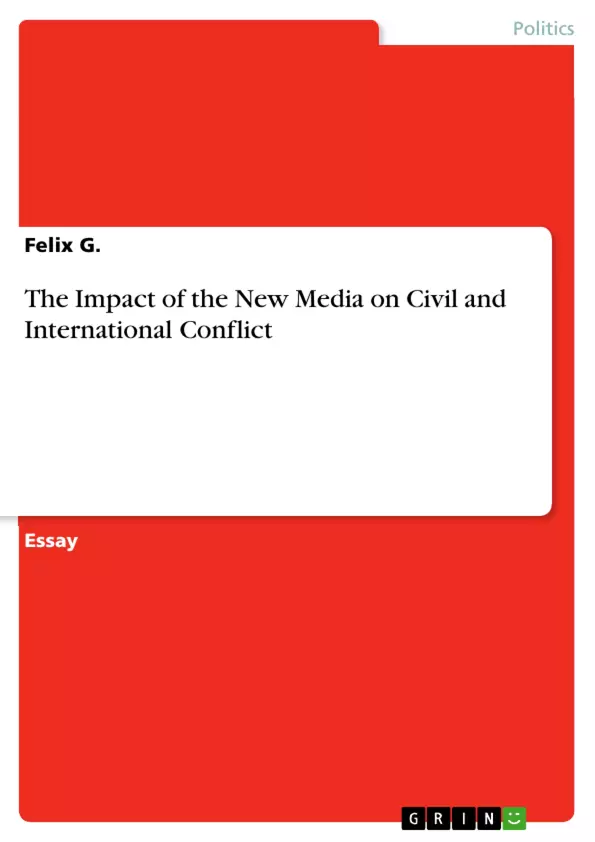The media has always played a major role in conflicts. Ivan Sigal emphasises that “governments seek to hold onto power through persuasion as much as through force”. In the WWII the Nazis used the radio to broadcast their propaganda in and outside Germany. In Rwanda the radio was used to contrive the genocide of 1994, further the Serbian president Slobodan Milosevic used a government-controlled media to promote his nationalist ideologies in former Yugoslavia. Mass media such as radio, newspapers, television or even blogs and websites follow a one-to-many mode of communication. The mass media can stay active or independent in a conflict. Dependant on the orientation or suppression, the mass media becomes more or less part of the conflict. It can inform or influence the home audience, the opponent’s audience or the world. Social media such as Facebook, Twitter and YouTube, as a part of the new media, on the other hand is founded on a many-to-many mode of communication. This many-to-many communication gives everyone with internet access or even just a mobile phone the chance to provide or get authentic, transparent and reliable information to build a free opinion or report grievances. Social media spreads information virally so that one single actor is enough to spread a message globally. New media’s large influence has gained traction with a wide range of actors. From citizens over governments, protest movements or even terrorist groups, all these want to use the new technology to their own aims. I will discuss in this essay the impact of the new media on civil and international conflict situations in the contemporary era.
Inhaltsverzeichnis (Table of Contents)
- The Impact of the New Media on Civil and International Conflict
- New Media in Conflict Situations
- Protests and New Media
- Governments and New Media
- Terrorism and New Media
- Conclusion
Zielsetzung und Themenschwerpunkte (Objectives and Key Themes)
This essay examines the influence of new media on civil and international conflicts in the contemporary era. It explores how new media platforms, particularly social media, have transformed the way individuals, governments, protest movements, and terrorist groups engage in conflict dynamics.
- The role of new media in reporting grievances, deception, and repression
- The impact of social media on the formation and organization of protests
- The potential for governments to manipulate and control social media
- The use of social media by terrorist organizations for recruitment and propaganda
- The potential both positive and negative of new media in resolving conflicts
Zusammenfassung der Kapitel (Chapter Summaries)
- The essay begins by outlining the historical role of mass media in conflicts and introduces the concept of new media, emphasizing its defining characteristics and its potential for shaping public opinion.
- The essay then explores specific examples of how new media platforms have been used to report on conflict situations, such as the bombing of Azizabad in Afghanistan and the Burmese monk protest in 2007. These cases demonstrate the power of new media to challenge official narratives and disseminate information independently.
- The essay further analyzes how social media has facilitated the organization of protests, citing examples from Pakistan, the Arab Spring, and Hong Kong's Umbrella Movement. While acknowledging the positive potential of social media in mobilizing citizens, the essay also highlights the challenges associated with its reliance, including issues of age, strategic thinking, and government manipulation.
- The essay explores the utilization of social media by terrorist groups, focusing on the Islamic State's use of platforms like Facebook and Twitter for recruitment and propaganda. The essay underscores the global reach and impact of these actions, citing responses from world leaders.
Schlüsselwörter (Keywords)
This essay delves into the multifaceted impact of new media on conflict dynamics, highlighting key themes such as social media, citizen activism, government control, terrorism, and the dualistic nature of technological tools. It explores the influence of platforms like Facebook, Twitter, and YouTube on contemporary conflicts and analyzes the implications for democratic societies and the international landscape.
- Citar trabajo
- Felix G. (Autor), 2014, The Impact of the New Media on Civil and International Conflict, Múnich, GRIN Verlag, https://www.grin.com/document/416857



